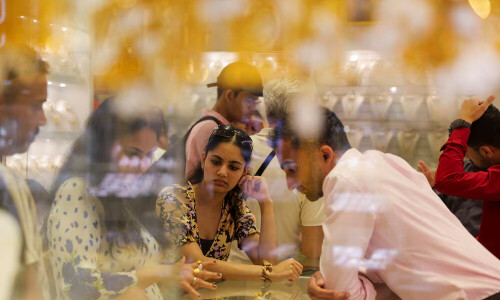Dubai’s Gold Souk Sees Shift as Prices Surge
In Dubai’s famous Gold Souk, often called the “City of Gold,” 22-karat gold jewelry has long been a popular choice for weddings, religious events, and family savings.
However, with gold prices reaching unprecedented levels above $3,400 per ounce, the market is showing signs of change as buyers explore diamonds and lighter gold pieces instead.
According to Andrew Naylor, head of Middle East and Public Policy at the World Gold Council (WGC), while U.S. tariffs and other variables have boosted gold’s attraction as a safe investment, the effect on gold jewelry is different.
“In locations like Dubai, this generates a dual outcome: increased interest in gold as a secure asset, but also reduced demand for jewelry due to high prices.”
Retailers Observe Changing Trends
Retailers in Dubai’s Gold Souk have noted that rising prices are causing consumers to seek alternatives.
Fahad Khan, a sales representative at Damas Jewellery, stated, “There aren’t many potential customers these days because of the cost of gold.”
Lalita Dave, 52, shopping in the Gold Souk, commented, “It’s somewhat difficult to afford gold, so I believe diamonds are a better option.”
The Rise of Lab-Grown Diamonds
For at least 80 years, Dubai has attracted gold buyers, initially from Iranian and Indian traders who share a tradition of using 22-karat jewelry for decoration and investment.
But as gold prices increased by 27% last year, demand for gold jewelry in the UAE fell by about 13%, outpacing the global drop of 11%, according to the WGC.
The WGC’s gold demand trends report, released in February, indicated that jewelry demand may face additional pressure in important regions in 2025 if gold prices stay high or volatile.
The report emphasized that price fluctuations, more than price levels, are increasingly influencing consumer behavior, particularly in India.
Changes in Indian purchasing patterns frequently have an impact on Gulf markets like the UAE, where buyers are major sales drivers.
Goldman Sachs recently increased its end-2025 gold forecast to $3,700 per ounce, suggesting that prices could reach as high as $4,500.
Russ Mould, investment director at AJ Bell, noted, “Higher gold prices are expected to reduce demand for jewelry, demonstrating how high prices can serve as their own remedy.”
The increasing popularity of lab-grown diamonds is one sign of cost-cutting.
Data from the Gem and Jewellery Export Promotion Council revealed that India’s exports of lab-grown diamonds to the UAE totaled $171 million in 2024, up nearly 57% from $109 million two years prior.
India’s exports of cut and polished diamonds to the UAE increased by 3.7% between April and November 2024.
The UAE was the third-largest importer of diamonds globally in 2023, according to trade data, with India, South Africa, and Belgium being its primary trading partners.
While the UAE accounted for only 1.5% of the global diamond jewelry market by revenue in 2023, Grand View Research predicts it will grow by 5.9% per year to reach approximately $2 billion by 2030.
This growth rate exceeds the global forecast of 4.5%, making the UAE the fastest-growing market in the Middle East and Africa.
Trade Tensions and Alternative Markets
According to two executives at major Indian diamond exporters, recent trade tensions with the United States have expedited discussions about identifying alternative markets and production centers.
One source, who wished to remain anonymous, told Reuters that if tensions persist, possibly for years, his company’s contingency plans include relocating some Indian production overseas, including to the UAE.
Shamlal Ahamed, managing director of international operations at retailer Malabar Gold & Diamonds, informed Reuters that the rise in lab-grown diamond jewelry sales in the UAE appeared to be motivated more by design choices than by pricing, and he remained optimistic about gold jewelry demand.
“While price-sensitive buyers may wait for a decrease, our experience suggests that such declines are frequently short-lived, with buyers quickly adjusting to new price levels.”



Comments (0)
No comments yet. Be the first to comment!
Leave a Comment